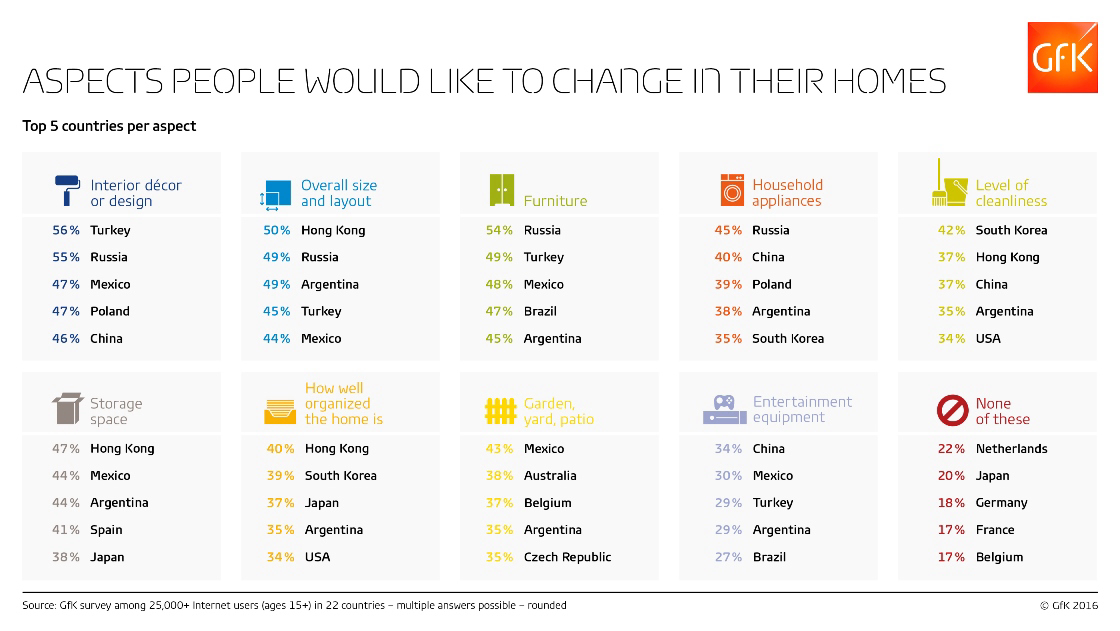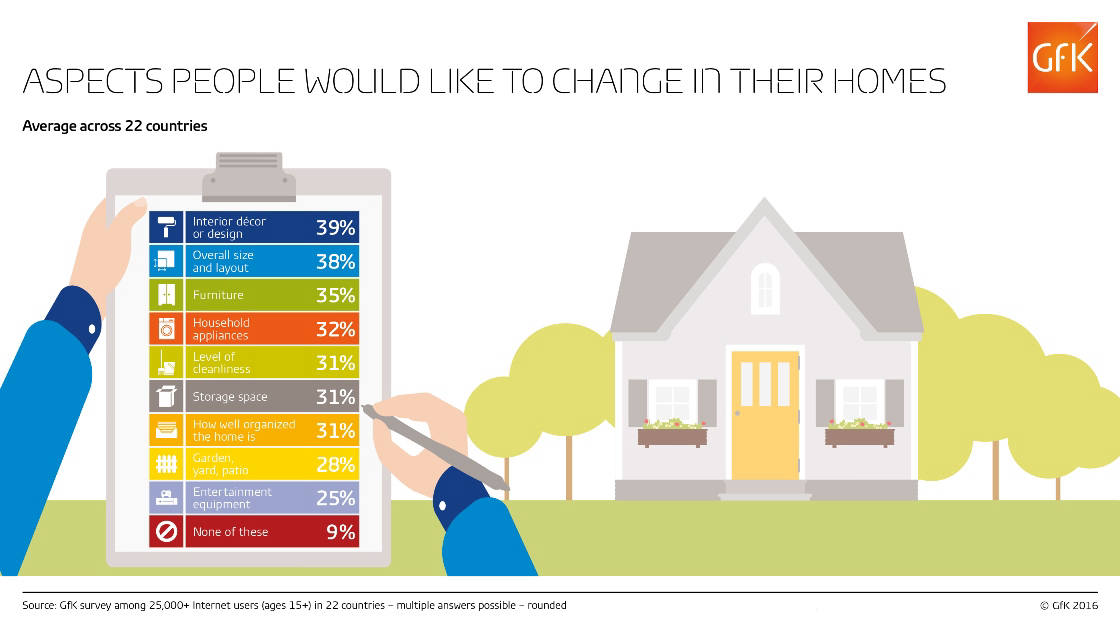GfK research shows that storage space and overall size also rank high on Americans’ home “to do” lists
A new GfK study reveals that five priorities tie for the #1 spot on Americans’ home improvement task aspiration lists. More than one third of households (34%) chose each of these as being important areas for improvement – home organization, furniture, storage space, overall size and layout, and level of cleanliness.
According to a survey of 22 countries, when it comes to home improvements, the most popular priorities globally among the online population are interior design (39 percent), overall size or layout (38 percent), and furniture (35 percent).
The desire to improve the home’s overall size and layout is most prevalent in Hong Kong (50%), Russia (49%) and Argentina (49%); while furniture is a top priority in Russia (54%), Turkey (49%), and Mexico (48%).
Gender has strong impact on home improvement choices
Looking at the differences between genders, US women are more likely to want change their home furnishings, with 40% selecting that as a top goal. The runner-up choices among US women are home organization (39%), storage space, level of cleanliness and overall size (all at 37%).
Among women internationally, interior décor was chosen most often, with 43% selecting it as one of the aspects they would most like to improve. Their next most popular choices are furniture (40%) and overall size and layout (39%).
Among US men, the overall size and layout is the aspect of their home they would most like to improve, with almost one-third (30%) selecting this project. This renovation choice is also highly favored internationally by men, with more than one-third (37%) selecting it globally.
Age impacts most home improvement choices
Among the different age groups in the US, people in their late teens (ages 15 to 19) show the greatest interest in improving the level of cleanliness of their homes, with a (40%) selection rate. People in their twenties (ages 20 to 29) would like to improve the furniture in their homes the most, with a 40% level.
For those in their thirties (30 to 39), the overall size and layout of their homes holds the greatest importance, with 39 percent selecting this priority.
One third (33%) of those in the 40 to 49 age group express a strong desire to improve their home storage space. People who would most like to upgrade their gardens, yards, patios or any other outdoor areas are those in the 50-to-59 (36%) and 60+ (37%) age groups.
GfK’s findings form a valuable foundation for major DIY, home furnishing and home improvement retailers in understanding how consumer aspirations for their homes differ across countries, age groups and gender. By combining these aspirational data with its continuous point of sales tracking, GfK gives its clients a detailed picture of the current and future demands within each target market.
To download full findings for each of the 22 markets, please visit


About the study
The survey question asked, “Which of these aspects of your home would you most like to change or improve, if you could? Select all that apply.”
GfK conducted the online survey with 27,000 consumers aged 15 or older across 22 markets. Fieldwork was completed in June 2015 and data are weighted to reflect the demographic composition of the online population age 15+ in each market. The markets included are Argentina, Australia, Belgium, Brazil, Canada, China, Czech Republic, France, Germany, Hong Kong, Italy, Japan, Mexico, Netherlands, Poland, Russia, South Korea, Spain, Sweden, Turkey, UK and USA.
About GfK
GfK is the trusted source of relevant market and consumer information that enables its clients to make smarter decisions. More than 13,000 market research experts combine their passion with GfK’s long-standing data science experience. This allows GfK to deliver vital global insights matched with local market intelligence from more than 100 countries. By using innovative technologies and data sciences, GfK turns big data into smart data, enabling its clients to improve their competitive edge and enrich consumers’ experiences and choices.
For more information, please visit www.gfk.com or follow GfK on Twitter: https://twitter.com/GfK




